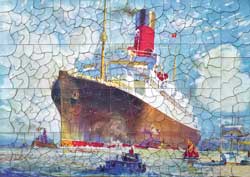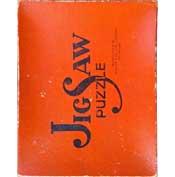Peacock & Co. jigsaws
Peacock & Company had been producing toys and jigsaws for over 40 years before the founders of Chad Valley established their factory in Harborne. They were one of the many companies bought out by Chad Valley over the years and it would appear that their products and packaging design influenced those of their new owners.
Peacock & Co. Ltd.
During the late 1830s Edward James Peacock worked as a manager with Edward Wallis an established publisher and map dissector in London. He left for Australia in 1841 but returned to England in 1853 and began making children’s furniture, toys and dissected maps himself under the name Peacock & Company and based at 3 Adelaide Terrace in London. In 1861, his son, William, took over the company, expanding it to become recognised as a leading producer of high quality wooden puzzles in distinctive wooden boxes with sliding lids. Cardboard boxes were introduced at the turn of the century. William continued until 1910 when, on his death, the firm passed to his two sons William Edward and Albert Frank, William Edward was to turn the firm into a Limited Company in 1918, still working from the same address. Despite a major fire in 1926 the firm continued to expand, eventually outgrowing the old premises new ones were built at 175/179 St Johns Street in 1931. Peacocks introduced cardboard puzzles at that time and the toy side of the firm were producing an increasingly large range which now included Teddy Bears. William Edward Peacock retired in 1934 aged 64 with the firm being taken over by Chad Valley.
~~~~~~ ooooooOOOoooooo ~~~~~~
Click or tap on any jigsaw thumbnail to see a larger image.
~~~~~~ ooooooOOOoooooo ~~~~~~
Die-cut card puzzle
It is interesting to compare the boxes below with those later used by Chad Valley for the wooden jigsaws which they produced for BOOTS in the mid to late 1930s. The boxes are identical in design, with the same very large 'JigSaw PUZZLE' motif. The only differences are that the BOOTS boxes carry the words '3 PLY WOOD INTERLOCKING' and 'Specially Manufactured for BOOTS by THE CHAD VALLEY CO. LTD. Harborne England', rather than 'MANUFACTURED BY PEACOCK & CO. LTD., LONDON, TOY MAKERS' or 'MANUFACTURED BY THE CHAD VALLEY CO., LTD.,HARBORNE, ENGLAND'.


384 pieces (approx. 21⅝" x 15")
The painting is by Walter Thomas whose signature is rather indistinct near the bottom left corner. Whilst the vessel carries no name, and so is representative of the six which made up the 'A' class of liner (Ausonia, Andania, Antonia, Aurania, Ascania and Alaunia), it is known to show Antonia off the coast of Quebec beginning a return voyage to England. The ship was launched in 1921 and made her maiden voyage from London to Quebec in June 1922. Painted in 1922, this image was used for the poster introducing Cunard's new Canadian service for which the six sister vessels were built, and also by Chad Valley from about 1926 on wood puzzles produced by them for Cunard.
This puzzle is contained in a plain orange lift-off lid box about 7½" x 5¾" x 2" in size. Printed on the lid are the words 'MANUFACTURED BY PEACOCK & CO. LTD., LONDON, TOY MAKERS', and 'Jig Saw PUZZLE' in large letters, but no indication as to the contents. A small monochrome guide picture with the puzzle name below is however included loose in the box. This puzzle must date from before 1934 when Peacock & Co. were taken over by Chad Valley. We have also seen an example of this puzzle in the same Peacock box, but with the words Cunard Line. in the bottom right corner of the completed puzzle.
with the puzzle name below is however included loose in the box. This puzzle must date from before 1934 when Peacock & Co. were taken over by Chad Valley. We have also seen an example of this puzzle in the same Peacock box, but with the words Cunard Line. in the bottom right corner of the completed puzzle.
This is a card puzzle, or rather an assemblage of eleven smaller card puzzles to form one whole. This probably results from the fact that early presses were not powerful enough to cut a large puzzle in one operation, so they would be first cut into more manageable sections. This puzzle consists of eight 45 piece elements each about 9½" x 3¾", and three 8 piece elements each about 5" x 2⅝". Close examination reveals that one of both the eight larger and the three smaller sections are cut upside down when compared to the others.
This version of the puzzle is contained in a plain orange lift-off lid box identical to that of the Peacock Toys version, but now printed on the lid are the words 'MANUFACTURED BY THE CHAD VALLEY CO., LTD.,HARBORNE, ENGLAND'. Again there is no indication as to the contents and the small guide picture which would presumably have been loose in the box is missing. It does differ slightly in size with some cropping of the image apparent at both the top and bottom. This puzzle consists of eight 45 piece elements each about 9½" x 3⅝", and three 8 piece elements each about 4⅞" x 2½". Close examination reveals that two of the the eight larger and one of the three smaller sections are cut upside down when compared to the others.
It was difficult to measure these two puzzles accurately as they are push fit and that would introduce a certain variation, but probably not enough to explain the difference in sizes as measured. It is possible that the cutting dies were replaced at some point and, being made by hand, might well have ended up slightly smaller.






